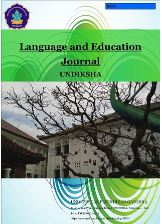STUDENTS’ PERCEPTION ON GOOGLE CLASSROOM ASSISTED LEARNING IN LIMITED FACE-TO-FACE INSTRUCTIONS DURING THE PANDEMIC
Kata Kunci:
Presepsi Siswa, Google Classroom, Pembelajaran Bahasa InggrisAbstrak
Penelitian ini bertujuan untuk mengidentifikasi dan menganalisis persepsi siswa terhadap penggunaan Google Classroom dalam pembelajaran bahasa Inggris secara daring dan investigasi terhadap persepsi siswa tersebut menjadi perlu karena dapat digunakan sebagai bahan pertimbangan bagi sekolah untuk memfasilitasi pembelajaran tatap muka atau tidak menggunakannya sama sekali. Penelitian ini dirancang dengan menggunakan penelitian Mixed Method dimana Data Kuantitatif Deskriptif lebih dominan, sedangkan data kualitatif digunakan sebagai data pendukung. Pengumpulan data dilakukan melalui dua instrumen yaitu kuesioner dan pedoman wawancara. SMP N 1 Kubutambahan dipilih sebagai setting penelitian dan 63 siswa dipilih sebagai subjek penelitian. Hasil penelitian menunjukkan bahwa rata-rata skor data adalah 3,64. Hal ini menunjukkan bahwa siswa SMP N 1 Kubutambahan memiliki persepsi positif terhadap pembelajaran berbantuan Google Classroom. Berdasarkan data wawancara, sebagian besar siswa memiliki persepsi positif terhadap pembelajaran berbantuan Google Classroom. Meski kesulitan, mayoritas siswa ingin tetap menggunakan Goggle Classroom untuk membantu proses pembelajaran.
Referensi
Al-Maroof, R. A. S., & Al-Emran, M. (2018). Students acceptance of google classroom: An exploratory study using PLS-SEM approach. International Journal of Emerging Technologies in Learning, 13(6), 112–123. https://doi.org/10.3991/ijet.v13i06.8275
Alim, N., Linda, W., Gunawan, F., & Saad, M. S. M. (2019). The effectiveness of Google classroom as an instructional media: A case of state islamic institute of Kendari, Indonesia. Humanities and Social Sciences Reviews, 7(2), 240–246. https://doi.org/10.18510/hssr.2019.7227
Ari, N. P. J. (2021). Students’ Perception on the use of Google Classroom in Teaching and Learning during Pandemic of Covid-19. Journal of Educational Study, 1(2), 37–44. https://doi.org/10.36663/joes.v1i2.178
Astuti, N. W. (2021). “I Feel Less Judged, so I Speak More” Introverted Students’ Response on Online Learning Platforms in Speaking Class. JETLe (Journal of English Language Teaching and Learning), 2(2), 8–14.
Basaran, U. (2016). Examining the Relationships of Cognitive, Affective, and Conative Destination Image: A Research on Safranbolu, Turkey. International Business Research, 9(5), 164.
Chowdhury, S. K., & Salam, M. (2015). Predicting attitude based on cognitive, affective and conative Components : An online shopping perspective. Stamford Journal of Business Studies, 6/7(II/I), 101–115.
Cresswell, J. W. (2012). Educational Research. Pearson.
Čvirik, M. (2020). The Cognitive , Affective and Conative Components of Consumer Behaviour in the Context of Country of Origin : A Case of Slovakia. Central and Eastern Europe InThe Changing Business Environment, January, 23–33. https://doi.org/10.18267/pr.2020.cer.2395.3
Duraku, Z. H., & Hoxha, L. (2020). The impact of COVID-19 on education and on the well- being of teachers, parents, and students: Challenges related to remote (online) learning and opportunities for advancing the quality of education. In Impact of the COVID-19 Pandemic on Education and Wellbeing (pp. 17–45). University of Prishtina “Hasan Prishtina” Faculty of Philosophy.
Harjanto, A. S., & Sumarni, S. (2019). Teacher’s Experiences on The Use of Google Classroom. 3rd English Language and Literature International Conference (ELLiC), 3, 172–178.
Hrastinski, S. (2008). Asynchronous and Synchronous E-Learning. Educause Quaterly, 4, 51–55.
Jumroh, J., English, O. R.-I. J. of, & 2019, undefined. (2019). the Influence of Student’S Perception on Learning Media and Student’S Motivation Toward Student’S English Achievement. Journal.Lppmunindra.Ac.Id, 2(1), 1–10.
Mairing, J. P., Sidabutar, R., Lada, E. Y., & Aritonang, H. (2021). Synchronous and asynchronous online learning of advanced statistics during Covid-19 pandemic. Journal of Research and Advances in Mathematics Education, 6(3),
Mardiana, H. (2020). Lecturers’ Adaptability To Technological Change And Its Impact On The Teaching Process. JPI (Jurnal Pendidikan Indonesia), 9(2), 275. https://doi.org/10.23887/jpi-undiksha.v9i2.24595
Nurkancana, W. (1986). Evaluasi Pendidikan. Usaha Nasional.
Rukmana, G. W. (2021). Students’ Perception toward the Use of Google Classroom as Teaching and Learning English Media for EFL Students. Journal of Educational Study, 1(3), 191–199. https://doi.org/10.36663/joes.v1i3.167
Wahyuni, O. T. (2021). the Effects of Student ’ S Perception on Learning Technique and Learning Motivation on Students ’. INFERENCE: Journal of English Language Teaching, 4(2), 193–199.
Unduhan
Diterbitkan
Cara Mengutip
Terbitan
Bagian
Lisensi
Hak Cipta (c) 2022 Novita Febrianti, Ni Nyoman Padmadewi

Artikel ini berlisensiCreative Commons Attribution-ShareAlike 4.0 International License.










